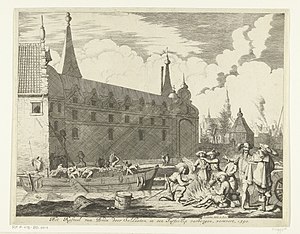
Sir Francis Vere was a prominent English soldier serving under Queen Elizabeth I fighting mainly in the Low Countries during the Anglo-Spanish War (1585–1604) and the Eighty Years' War.
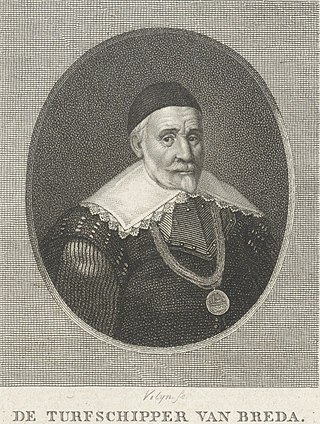
A Dutch skipper from Leur, Adriaen van Bergen devised the plot to recapture the city of Breda from the Spanish during the Eighty Years' War. In February 1590, he approached Prince Maurice with a Trojan Horse-type plan.
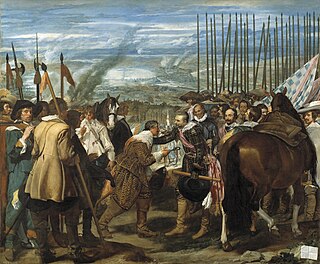
The Siege of Breda of 1624–1625 occurred during the Eighty Years' War. The siege resulted in Breda, a Dutch fortified city, falling into the control of the Army of Flanders.

The Siege of Bergen op Zoom was a siege that took place between September 23 - November 13, 1588, during the Eighty Years' War and the Anglo–Spanish War. The siege took place in the aftermath of the Spanish Armada when famed commander Alexander Farnese, the Duke of Parma attempted to use his forces to besiege Bergen op Zoom, which was held by an Anglo-Dutch force under Thomas Morgan and Peregrine Bertie. An English officer named Grimstone, claiming to be a disaffected Catholic, had set up a trap during which a large Spanish assault was bloodily repulsed. An Anglo-Dutch relief column under the command Maurice of Orange arrived soon after and forced the Duke of Parma to retreat, thus ending the siege.

The Battle of Kallo was a major field battle fought from 20 to 21 June 1638 in and around the forts of Kallo and Verrebroek, located on the left bank of the Scheldt river, near Antwerp, during the second phase of the Eighty Years' War. Following the symbolic recovery of Breda during the 1637 campaign, the Dutch Republic agreed with the French Crown, with whom it had allied in 1635, to besiege a major city in the Spanish Netherlands during the 1638 campaign. The commander of the Dutch States Army, Frederick Henry of Orange, planned an approach over Antwerp from the two sides of the Scheldt. After marching the army, Frederick Henry transferred 50 barges to Count William of Nassau-Siegen and he was left entrusted to land in the Spanish-controlled Waasland region, west of Antwerp, to seize the forts of Kallo and Verrebroek, along with several other key fortifications, to invest Antwerp from the west. In the meantime, Frederick Henry would advance on the opposite bank to complete the blockade of the city while the armies of France invaded the Spanish Netherlands from the south to oblige the Spanish Army of Flanders to divide its forces.

The siege of Zutphen was an eleven-day siege of the city of Zutphen by Dutch and English troops led by Maurice of Nassau, during the Eighty Years' War and the Anglo–Spanish War. The siege began on 19 May 1591 after a clever ruse by the besiegers. The city was then besieged for eleven days, after which the Spanish garrison surrendered.

The siege of Rheinberg took place from the 9 to 19 August 1597 during the Eighty Years' War and the Anglo–Spanish War by a Dutch and English army led by Maurice of Orange. The siege ended with the capitulation and the withdrawal of the Spanish after much unrest in the garrison. The liberation of the city of Rheinberg was the commencement of Maurice's campaign of 1597, a successful offensive against the Spaniards during the period known as the Ten Glory Years.
The Capture of Geertruidenberg of 1589, also known as the English betrayal of Geertruidenberg, took place on April 10, 1589, at Geertruidenberg, Duchy of Brabant, Flanders, during the Eighty Years' War and the Anglo-Spanish War (1585–1604).

The Capture of Geertruidenberg was a military event that took place on 28 August 1573 during the Eighty Years' War and the Anglo–Spanish War. The capture was conducted by an English, French Huguenot, and Flemish force led by Colonel de Poyet. A small assault force led by Walter Morgan captured the main gate which enabled the complete surprise of the garrison, most of whom were put to the sword.

The siege of Steenwijk was a siege that took place between 30 May and 5 July 1592 as part of the Eighty Years' War and the Anglo–Spanish War by a Dutch and English force under Maurice of Orange. By taking Steenwijk the Republic's army would take out one of the two main transport routes overland to the Drenthe capital of Groningen, the other lay at Coevorden. After a failed bombardment, an assault was made in conjunction with the detonation of mines under important bastions, and with two out of three successfully assaulted, the Spanish troops surrendered on 5 July 1592 and handed over the city to the Dutch and English army. This siege was one of the first in history to make use of pioneers as a separate military unit although they were still at the time regarded as soldiers.

The siege of Knodsenburg, Relief of Knodzenburg or also known as Battle of the Betuwe was a military action that took place during the Eighty Years' War and the Anglo–Spanish War at a sconce known as Knodsenburg in the district of Nijmegen. A siege by a Spanish army under the command of the Duke of Parma took place from 15 to 25 July 1591. The fort was defended by the Dutch Republic's commander Gerrit de Jong and his company which was then subsequently relieved through the intervention of a Dutch and English army led by Maurice of Orange and Francis Vere, respectively, on 25 July. As a result, the Spanish army was defeated and Parma managed to retreat by getting his army across the River Waal.

The siege of Coevorden was a siege that took place between 26 July and 2 September 1592 during the Eighty Years' War and the Anglo–Spanish War at the city of Coevorden by a Dutch and English force under overall command of Maurice of Nassau. The city was defended by Frederik van den Bergh who had been commissioned for the defence by King Philip II of Spain.
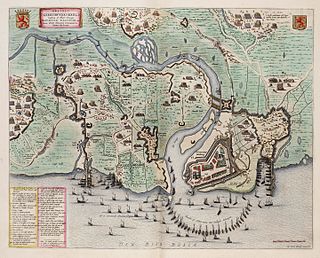
The siege of Geertruidenberg was a siege of the city of Geertruidenberg that took place between 27 March and 24 June 1593 during the Eighty Years' War and the Anglo–Spanish War. Anglo-Dutch troops under the commands of Maurice of Nassau and Francis Vere laid siege to the Spanish garrisoned city. The siege was unique in that the besiegers used a hundred ships, forming a semicircle in a chain on the Mass river to form a blockade. A Spanish force under the command of the Count of Mansfeld attempted to relieve the city in May, but they were defeated and later forced to withdraw. Three Governors of the city were killed – after the last fatality and as a result of the failed relief, the Spanish surrendered the city on 24 June 1593. The victory earned Maurice much fame and had thus become a steadfast strategist in the art of war.

The siege of Nijmegen was a military engagement during the Eighty Years' War and the Anglo–Spanish War which took place from 17 to 21 October 1591. The Spanish garrison in Nijmegen was besieged by a Dutch and English force under Maurice of Nassau and Francis Vere respectively and surrendered soon.

The siege of Coevorden was a thirty-one-week siege of the city of Coevorden in the province of Drenthe by the Spanish general Francisco Verdugo during the Eighty Years' War and the Anglo–Spanish War. The siege first commenced in October 1593, but winter and shortages of food and supplies forced the Spanish into winter quarters. The siege however recommenced in March 1594, but on May 6 Maurice of Orange arrived with an Anglo-Dutch army to relieve Coevorden, forcing the Spanish army under Francisco Verdugo to retreat.

The siege of Groningen was a two-month siege which commenced on 19 May 1594, and which took place during the Eighty Years' War and the Anglo-Spanish War. The Spanish-held city of Groningen was besieged by a Dutch and English army led by Prince Maurice of Orange. The Spanish surrendered the city on 22 July, after a failed relief attempt by the Count of Fuentes.
The Luxembourg campaigns were two military campaigns by the Dutch Republic and the Duchy of Bouillon against the Spanish Southern Netherlands during the Eighty Years' War in 1593 and 1595. The first was undertaken by a Dutch States Army commanded by Philip of Nassau to the Duchy of Luxembourg in early 1593, with the aim of distracting the Spanish Army of Flanders to a different part of the Habsburg Netherlands, create confusion and block the importation of new pro-Spanish troops to the Low Countries via the Spanish Road. Other goals were dealing economic damage to Spain, and supporting the Protestant claimant to the French throne Henry of Navarre and the Protestant prince of Sedan and duke of Bouillon, Henry de La Tour d'Auvergne.

The Sack of Lier, also known as the Fury of Lier in the Southern Netherlands, took place on 14 October 1595 when a force of the Dutch States Army led by Charles de Heraugières, governor of Breda, took the town by surprise during the Eighty Years' War. Heraugières, who was known for his daring surprise attacks over Breda in 1590 and Huy in March 1595, had been instructed to capture Lier ahead a small elite force while the bulk of the Spanish Army of Flanders was deployed in northern France and the Lower Rhine. The possession of Lier would have provided the Dutch Republic an advanced base deep inside the Brabant, which would allowed the States troops to cut the communications between Antwerp, Mechelen, Leuven and 's-Hertogenbosch, and to raid as far as Brussels.

The Ten Years were a period in the Eighty Years' War spanning the years 1588 to 1598. In this period of ten years, stadtholder Maurice of Nassau, the future prince of Orange and son of William "the Silent" of Orange, and his cousin William Louis, Count of Nassau-Dillenburg and stadtholder of Friesland as well as the English general Francis Vere, were able to turn the tide of the war against the Spanish Empire in favour of the Dutch Republic. They achieved many victories over the Spanish Army of Flanders, conquering large swathes of land in the north and east of the Habsburg Netherlands that were incorporated into the Republic and remained part of the Netherlands into the present. Starting with the important fortification of Bergen op Zoom (1588), Maurice and William Louis subsequently took Breda (1590), Zutphen, Deventer, Delfzijl, and Nijmegen (1591), Steenwijk, Coevorden (1592) Geertruidenberg (1593), Groningen (1594), Grol, Enschede, Ootmarsum, and Oldenzaal (1597)., recovering territories lost in 1580 through the treachery of George de Lalaing. Maurice's most successful years were 1591 and 1597, in which his campaigns resulted in the capture of numerous vital fortified cities, some of which were regarded as "impregnable". His novel military tactics earned him fame amongst the courts of Europe, and the borders of the present-day Netherlands were largely defined by the campaigns of Maurice of Orange during the Ten Years.
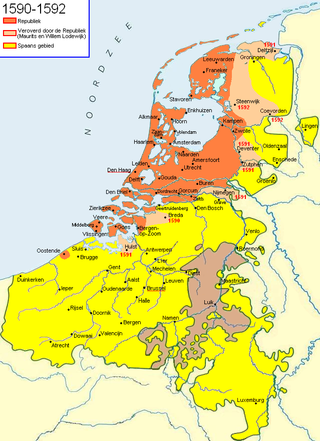
Maurice's 1591 campaign was a major campaign during the Eighty Years' War, during the campaign Maurice of Nassau was able to recapture the cities of Nijmegen, Deventer, Zutphen, Delfzijl, Hulst and Knodsenburg.


